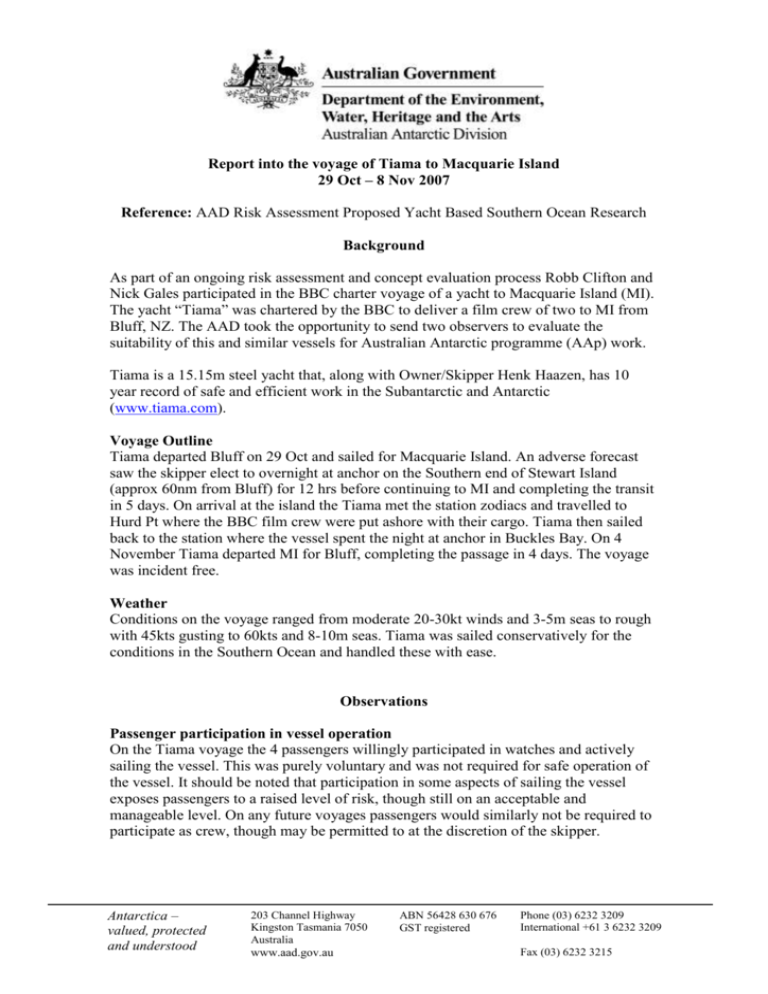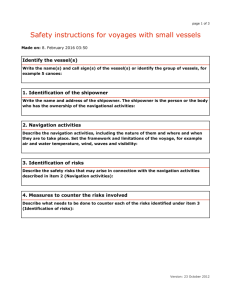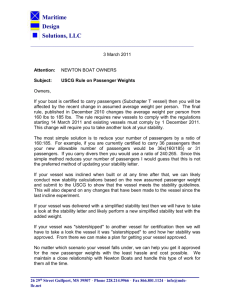Tiama Voyage report
advertisement

Report into the voyage of Tiama to Macquarie Island 29 Oct – 8 Nov 2007 Reference: AAD Risk Assessment Proposed Yacht Based Southern Ocean Research Background As part of an ongoing risk assessment and concept evaluation process Robb Clifton and Nick Gales participated in the BBC charter voyage of a yacht to Macquarie Island (MI). The yacht “Tiama” was chartered by the BBC to deliver a film crew of two to MI from Bluff, NZ. The AAD took the opportunity to send two observers to evaluate the suitability of this and similar vessels for Australian Antarctic programme (AAp) work. Tiama is a 15.15m steel yacht that, along with Owner/Skipper Henk Haazen, has 10 year record of safe and efficient work in the Subantarctic and Antarctic (www.tiama.com). Voyage Outline Tiama departed Bluff on 29 Oct and sailed for Macquarie Island. An adverse forecast saw the skipper elect to overnight at anchor on the Southern end of Stewart Island (approx 60nm from Bluff) for 12 hrs before continuing to MI and completing the transit in 5 days. On arrival at the island the Tiama met the station zodiacs and travelled to Hurd Pt where the BBC film crew were put ashore with their cargo. Tiama then sailed back to the station where the vessel spent the night at anchor in Buckles Bay. On 4 November Tiama departed MI for Bluff, completing the passage in 4 days. The voyage was incident free. Weather Conditions on the voyage ranged from moderate 20-30kt winds and 3-5m seas to rough with 45kts gusting to 60kts and 8-10m seas. Tiama was sailed conservatively for the conditions in the Southern Ocean and handled these with ease. Observations Passenger participation in vessel operation On the Tiama voyage the 4 passengers willingly participated in watches and actively sailing the vessel. This was purely voluntary and was not required for safe operation of the vessel. It should be noted that participation in some aspects of sailing the vessel exposes passengers to a raised level of risk, though still on an acceptable and manageable level. On any future voyages passengers would similarly not be required to participate as crew, though may be permitted to at the discretion of the skipper. Antarctica – valued, protected and understood 203 Channel Highway Kingston Tasmania 7050 Australia www.aad.gov.au ABN 56428 630 676 GST registered Phone (03) 6232 3209 International +61 3 6232 3209 Fax (03) 6232 3215 2 Recommendation: Passengers on future yacht voyages participate in sailing the vessel only on a voluntary basis and where deemed appropriate by the master. Recommendation: Where for specific projects using yachts expeditioner participation is required the commensurate training and risk management is put in place. Fatigue Being involved in watch keeping along with the motion of the vessel resulted in some fatigue for the crew/passengers. This was managed well with a watch system allowing adequate time off for rest however a residual fatigue level was unavoidable. For future passenger transfers by such vessels it should be noted that there would be no requirement for watch keeping or direct participation by passengers, hence reducing fatigue levels. For voyages such as the proposed Antarctic Whale Expedition where expeditioner participation may be required, fatigue levels will have to be actively monitored and managed. Recommendation: Fatigue is considered in the planning for any yacht use for both transport and research work within the AAp and managed accordingly. Sea Sickness Passengers on smaller vessels will certainly be more prone to sea sickness and hence people with a pre disposition for suffering abnormally from sea sickness should not be sent on this form of transport. Of the 4 passengers on the Tiama voyage 2 suffered no effects, 1 experienced some effects for 24hrs and one felt somewhat unwell for the duration of the voyage. None of the sea sickness encountered was chronic or debilitating. Recommendation: People with a pre disposition for suffering abnormally from sea sickness should not be sent on yachts as part of the AAp. Safety The skipper of Tiama operated under an excellent safety culture. This included detailed briefings pre departure, the use of life jackets and harnesses for all deck work, the wearing of electronic man overboard alarms by all when on night watch, a conservative sailing plan, training in sail and vessel handing procedures and constant reminders and identification of the hazards on board during the voyage. The vessel is built to N.Z. Ministry of Transport Survey and to the requirements of International Standard ISO 9002, as a class VII ship engaged in international voyages. Tiama is a registered New Zealand Charter vessel under survey and operating under the New Zealand safe ship management system with a history of safe operations in the same conditions as those encountered on this voyage. Passengers felt safe at all times and the voyage was without incident. Recommendation: Future yachts chartered by the AAD are compliant with the risk assessment carried out as part of this evaluation process in order to ensure the necessary safety systems are in place. 3 Passenger Comfort Passengers were accommodated in bunks with 3 in double cabins and one in the main saloon area. Bunks were comfortable with all linen and bedding provided. The yacht had a very well equipped galley and the meals provided were excellent. A lounge area was also available for relaxation/ reading etc and the enclosed pilot house provided a fantastic protected area for passengers to spend time, even in rough conditions. The main cabin was heated for much of the voyage providing very good comfort in often cold conditions. The comfort levels could be likened to Antarctic Field huts, though possible more arduous, and this comparison could accurately be used when considering use of such vessels in the future. Recommendation: Passengers sent on yachts are comfortable living in a small group and in confined living environment similar, or more arduous, to that of an Antarctic Field Hut. Forecasting Specialised forecasting was provided by both the BoM and a private forecaster from NZ to support the voyage. These forecasts were accurate and very useful, particularly in the more Southerly part of the voyage. The standard range of publicly issued forecasts, weather fax and other data was also utilised. Recommendation: As for all AAp voyages the BoM continue to provide specialist forecasts to any yachts under AAp charter. Clothing Standard AAp clothing was taken on the voyage with the provision of one additional set of woollen underwear. This proved more than adequate in providing warm, functional and comfortable clothing. Musto wet weather clothing was also provided for each passenger by the vessel which proved highly effective for venturing into the cockpit or on deck. Issued AAp Goretex would also provide a similar level of protection for passengers on such vessels if they are not engaged in active crew work. For work on exposed decks the more specialised wet weather clothing is preferable. Boots were trialled by Robb and Nick with a view towards future Antarctic yacht based work however unfortunately these proved inadequate in keeping feet at a comfortable level of warmth. Medical The vessel has a comprehensive medical kit and the skipper is trained to a level similar to Wilderness First Aid. All passengers had undergone a standard AAp medical prior to departure. Polar Medicine provided sea sickness medication that was used by two of the four passengers intermittently. No medical issues arose, other than the previously mentioned sea sickness. Vessel Utility The utility of a small vessel was demonstrated throughout the voyage and in the operations off Hurd Pt. The vessel design allowed easy and safe transfer of cargo and passengers to the station zodiacs over the stern, despite a moderate to heavy swell. The small size and shallow draft of the yacht allowed it to be positioned in the safest and most efficient position for unloading operations which further enhanced its utility. The 4 potential for operations close to shorelines involving transfer of passengers and cargo, provision of accommodation around island areas and interaction with and observation of marine wildlife was demonstrated throughout the voyage. It should also be noted that this vessel, and assumedly similar vessels, has transported dogs to subantarctic islands as part of management programs. Biosecurity Tiama has a history of operating in the NZ Subantarctic and Antarctic and hence the skipper was very aware of and actively involved in ensuring biosecurity was maintained. This included the use of a boot wash for disembarking passengers, checking for seeds and propagules on clothing and equipment and general reminders of the need for all of the above. The small size of yachts and relative lack of confined spaces make quarantine checks a relatively easy undertaking and arguably the risk of breaches relatively minor when coupled with good education, awareness and culture surrounding such issues. Implications for the proposed AWE Given the Risk assessment already conducted and observations on the Tiama voyage the following points, while not generally new, are considered worth highlighting for the proposed AWE: Team Selection The relatively confined spaces and somewhat more arduous living conditions on board a yacht are not dissimilar to those found in field camps. For this reason any team selected for the AWE will have to be carefully considered in regards to the individual’s personal qualities and previous experience in similar living conditions. Vessel and Crew selection The successful completion of the Tiama voyage to MI is in large part a testament to the experience and planning of the particular skipper and crew and the suitability and condition of the vessel. For the AWE both the crew and vessel must be selected carefully to ensure success and safety of the expedition. Training The Tiama voyage reinforced the need for a well thought out training program involving basic sailing skills, OH&S at sea and other courses relevant to the proposed expedition. Leadership As with other recent AAp field expeditions the leadership aspect of the AWE will be critical in ensuring a safe, harmonious and productive voyage. Selection of specific leadership as an addition to, or from within, the team will be critical to the success of the expedition. Fatigue With a current intention for expeditioners to participate in vessel operations and a long ocean passage fatigue management will be vital. Expedition planning must factor in rest periods within the schedule to ensure this is done. 5 Conclusions The Tiama voyage, as part of the ongoing risk assessment and evaluation process, was a very valuable component of the consideration for the use of yachts as part of the AAp. Voyaging into the Southern Ocean in any vessel remains a serious undertaking requiring careful consideration, detailed preparation and rigorous risk assessment. The conclusion of this report is that within the bounds of the risk assessment and the recommendations above, the use of yachts for AAp logistic and research operations is a feasible, safe and effective way of delivering outcomes for specific projects and programmes.





